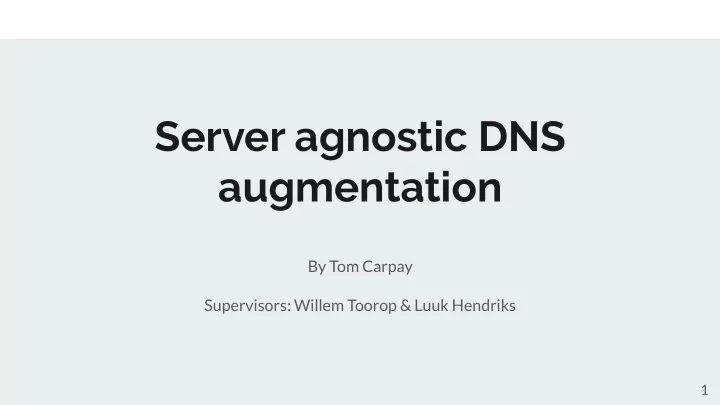

Server agnostic DNS augmentation By Tom Carpay Supervisors: Willem Toorop & Luuk Hendriks 1
Intro No DNS handling available low in the network stack, ● which is desirable for high volume authoritative servers Focus on DNS service agnostic ● Extended Berkeley Packet filter (eBPF) ● We don't fully know the possibilities of ● this technology 2
eBPF eBPF ● ○ Runs natively in Linux VM kernel space ○ Executes verified code ○ Limited instruction set ○ Execution limit (1 million instructions) ○ Different execution hooks Extensive high and low stack toolset used in ● many tracing tools Fig. Linux tracing tools using eBPF. Brendan Gregg 2018 3
Related work Knot DNS - Bypass the TCP/IP stack ● Cloudflare: L4 Drop - XDP DDOS ● protection Various papers evaluating eBPF ● performance Cloudflare’s L4Drop in action. 2018. 4
Research questions How can XDP eBPF be used to augment and improve DNS software? Which features from XDP eBPF could be used to augment DNS software? ● How can DNS augmentations be implemented based upon these XDP eBPF features? ● How do these implementations impact performance? ● 5
The eXpress Data Path hook XDP actions ● XDP_PASS ○ XDP_DROP ○ XDP_ABORTED ○ XDP_TX ○ XDP_REDIRECT ○ XDP IoVisor, 2018. 6
XDP eBPF features XDP & Traffic Control (TC) hooks ● Change packet size and contents ● Bypass network stack, XDP offloading ● Userspace “maps” and configuration e.g. ● ARRAY ○ HASHMAP ○ PERCPU_ARRAY ○ PERCPU_HASHMAP ○ LPM_TRIE ○ Fig. XDP in the network stack. Adapted from Quentin Monet, Netronome, 2018 7
Prototypes QName rewrite (collaborative work) ● Response Rate Limiting (RRL) ● ○ Basic prototype ○ Per IP RRL ○ Unknown host RRL 8
Response Rate Limiting How many packets have I seen in my Timeouts vs responses ● current time frame? Cut off after threshold Check time frame a percentage of ● the time Flamethrower tool to query NSD ● Check rate of 50%, time frame of 1 ● second, 10 second bursts 9
Response Rate Limiting cont. The combined CPU load per threshold 10
Discussion and future work Flamethrower measurements are subject to network variability ● RRL of NSD shows that the RRL prototype works, though it does not reduce timeouts ● CPU load dependent adaptive RRL ● DNS cookies ● 11
Summary Which features from XDP eBPF could be used to augment DNS software? ● Literature study ○ How can DNS augmentations be implemented based upon these XDP BPF features? ● Prototypes ○ How do these implementations impact performance? ● Experiments to validate and quantify prototypes ○ How can XDP BPF be used to augment and improve DNS software? Offload and add functionalities regardless of the DNS service ● 12
Recommend
More recommend